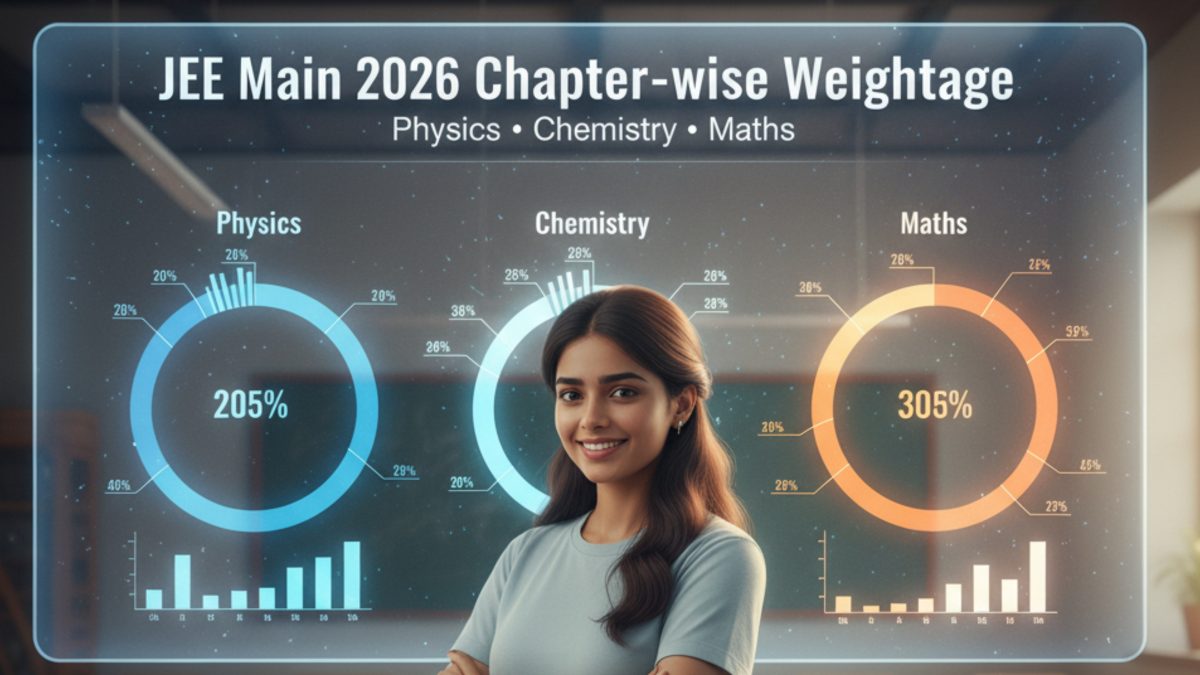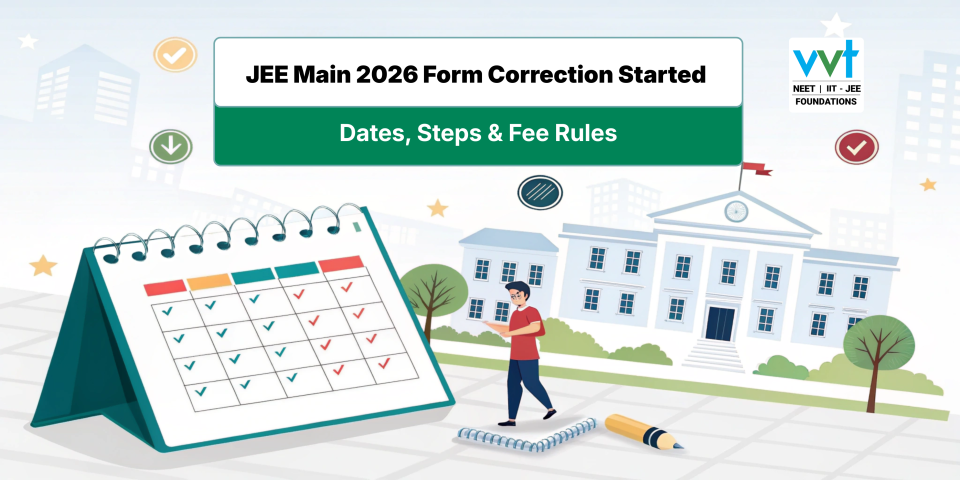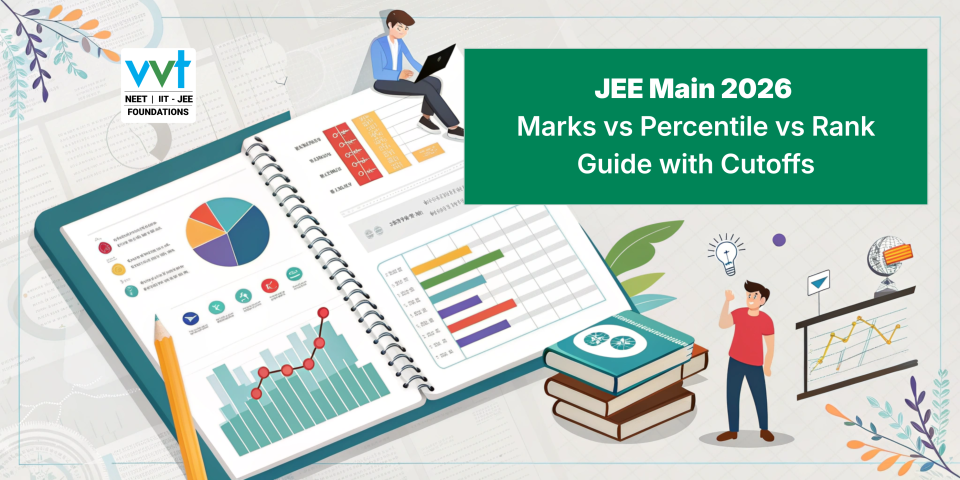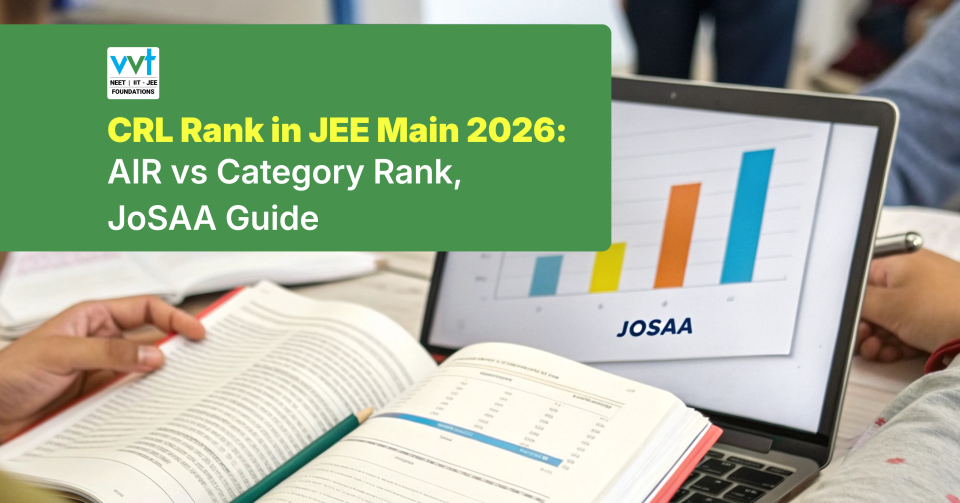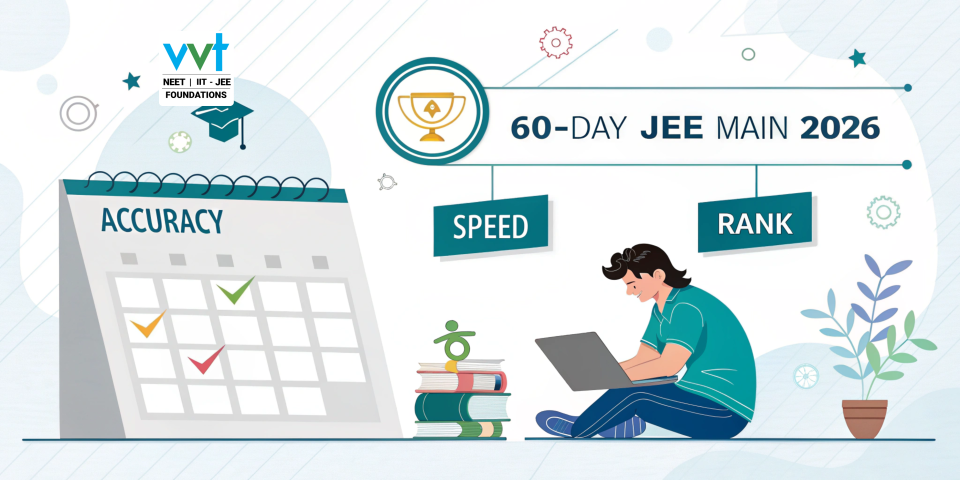
JEE Main 2026 Registration Begins Soon: Your Complete Guide to Applying and Preparing with Confidence!
October 4, 2025
Complete Guide to AYUSH Courses Under NEET 2025: Eligibility, Admission, Top Colleges & Career Scope
October 6, 2025JEE Main 2026 Chapter-wise Weightage for Physics, Chemistry & Maths
Preparing for JEE Main 2026 can feel overwhelming, especially when you’re dealing with such a vast syllabus. That’s why understanding the chapter-wise weightage becomes so important. By analyzing past years’ papers, you can figure out which topics are most important, where to invest more time, and how to balance your preparation.
This guide gives you the complete JEE Main chapter-wise weightage for Physics, Chemistry, and Mathematics, along with trends from the last five years. With this, you’ll know exactly which chapters carry more marks, and how to plan your study schedule smartly.
Why Chapter-wise Weightage Matters for JEE Main 2026
- Smarter Preparation – Focus on high-weightage chapters first to secure easy marks.
- Time Management – Avoid wasting hours on low-priority chapters.
- Balanced Revision – Use the analysis to create a balanced revision plan.
- Confidence Boost – Knowing expected topics reduces exam stress.
JEE Main Physics Chapter-wise Weightage 2026
Physics can be tricky, but it rewards students who understand concepts clearly. Over the years, certain topics like Modern Physics, Current Electricity, and Semiconductors have consistently carried higher weightage.
Here’s a detailed look at the chapter-wise Physics weightage based on past trends:
Class 11 Physics Chapter-wise Weightage
| Class 11 Chapters | Weightage (%) |
| Physics and Measurement | 2 |
| Kinematics | 1 |
| Laws of Motion | 3 |
| Work, Energy and Power | 3 |
| Rotational Motion | 1 |
| Gravitation | 1 |
| Properties of Solids and Liquids | 5 |
| Thermodynamics | 9 |
| Kinetic Theory of Gases | 3 |
| Oscillations and Waves | 3 |
Class 12 Physics Chapter-wise Weightage
| Class 12 Chapters | Weightage (%) |
| Electrostatics | 9 |
| Current Electricity | 8 |
| Magnetic Effects of Current and Magnetism | 5 |
| Electromagnetic Induction and Alternating Currents | 8 |
| Electromagnetic Waves | 5 |
| Optics | 10 |
| Dual Nature of Matter and Radiation | 6 |
| Atoms and Nuclei | 3 |
| Electronic Devices | 9 |
| Communication Systems | 5 |
Key Takeaway: Focus more on Optics, Thermodynamics, Modern Physics, and Electrostatics, as these consistently appear in the exam.
JEE Main Chemistry Chapter-wise Weightage 2026
Chemistry is often seen as the scoring subject in JEE Main.
With NCERT as the backbone, questions are usually straightforward if your concepts are clear.
Let’s break it down:
Class 11 Chemistry Chapter-wise Weightage
| Class 11 Chapters | Weightage (%) |
| Some Basic Concepts of Chemistry | 1 |
| Atomic Structure | 2 |
| Chemical Bonding and Molecular Structure | 5 |
| Chemical Thermodynamics | 8 |
| Equilibrium | 6 |
| The Redox Reaction | 3 |
| The Classification of Elements and Periodicity in Properties | 3 |
| The States of Matter | 2 |
| The Hydrogen | 1 |
| The s-Block Element (Alkali and Alkaline earth element) | 2 |
| The p-Block Element (Group 13 & Group 14 elements) | 3 |
| Hydrocarbons | 2 |
| Environmental Chemistry | 1 |
Class 12 Chemistry Chapter-wise Weightage
| Class 12 Chapters | Weightage (%) |
| Solid State | 2 |
| Solutions | 5 |
| Electrochemistry | 6 |
| The Chemical Kinetics | 4 |
| The Surface Chemistry | 2 |
| The General Principles and Processes of Isolation of Metals | 2 |
| The p-Block Element (Group 15, Group 16, Group 17 & Group 18 elements) | 7 |
| The d-Block Element (Transition element) | 7 |
| The f-Block Element (Lanthanides, Actinides) | 2 |
| The Coordination Compound | 6 |
| The Haloalkanes | 4 |
| The Haloarenes | 2 |
| The Alcohol, Phenol and Ether | 6 |
| The Aldehydes, Ketones and Carboxylic Acid | 5 |
| The Amines | 4 |
| The Biomolecules | 3 |
| The Polymers | 2 |
| The Chemistry in Everyday Life | 2 |
Key Takeaway: Thermodynamics, Equilibrium, Chemical Bonding, p-block, d-block, and Organic Chemistry are the most scoring areas.
JEE Main Mathematics Chapter-wise Weightage 2026
Maths can be lengthy, but with smart preparation, you can score well. Algebra, Calculus, and Coordinate Geometry usually dominate the paper.
Class 11 Mathematics Chapter-wise Weightage
| Class 11 Chapters | Weightage (%) |
| Sets, Relations and Functions | 3 |
| Complex Numbers and Quadratic Equations | 3 |
| Permutations and Combinations | 3 |
| Binomial Theorem and its Applications | 1 |
| Sequences and Series | 5 |
| Straight Lines and Pair of Straight Lines | 2 |
| Circles and Family of Circles | 2 |
| Conic Sections | 3 |
| Introduction to Three-dimensional Geometry | 2 |
| Limits and Derivatives | 2 |
| Statistics and Probability | 6 |
| Trigonometry | 3 |
| Mathematical Reasoning | 1 |
Class 12 Mathematics Chapter-wise Weightage
| Class 12 Chapters | Weightage (%) |
| Relations and Functions | 5 |
| Inverse Trigonometric Functions | 2 |
| Matrices and Determinants | 7 |
| Continuity and Differentiability | 6 |
| Application of Derivatives | 6 |
| Integrals | 9 |
| Differential Equations | 6 |
| Vectors | 5 |
| Three-dimensional Geometry | 6 |
| Probability | 7 |
Key Takeaway: Calculus, Matrices, Probability, and 3D Geometry are the most important for scoring high in Maths.
JEE Main 2026: Chapter-wise Weightage Analysis (Based on Previous Years)
The following tables show how marks were distributed in past sessions of JEE Main (2025 & earlier years). This helps predict which topics are expected to be important in JEE Main 2026.
Physics Chapter-wise Weightage (January 2025 Session)
| JEE Main 2025 Physics Chapter wise Questions | ||
| Chapter Name | April | Jan |
| Ray Optics and Optical Instruments | 19 | 23 |
| Units and Measurements | 13 | 20 |
| Rotational Motion | 13 | 14 |
| Electric Charges and Fields | 13 | 14 |
| Fluid Mechanics | 10 | 16 |
| Moving Charges and Magnetism | 12 | 12 |
| Thermodynamics | 9 | 13 |
| Electrostatic Potential and Capacitance | 12 | 9 |
| Wave Optics | 9 | 10 |
| Dual Nature of Radiation and Matter | 7 | 12 |
| Semiconductor Electronics: Materials, Devices and Simple Circuits | 9 | 10 |
| Current Electricity | 8 | 9 |
| Work, Power and Energy | 4 | 11 |
| Gravitation | 6 | 8 |
| Electromagnetic Waves | 5 | 9 |
| Thermal Properties of Matter | 5 | 8 |
| Waves | 10 | 3 |
| Alternating Current | 6 | 7 |
| Kinetic Theory of Gases | 7 | 5 |
| Atoms | 7 | 5 |
| Newton’s Laws of Motion | 8 | 3 |
| Motion in a Plane | 6 | 4 |
| Motion in a Straight Line | 5 | 4 |
| Simple Harmonic Motion | 4 | 5 |
| System of Particles and Centre of Mass | 3 | 5 |
| Nuclei | 5 | 3 |
| Mechanical Properties of Solids | 6 | 1 |
| Electromagnetic Induction | 1 | 6 |
| Magnetism and Matter | 3 | 0 |
| Vector and Calculus | 0 | 1 |
Chemistry Chapter-wise Weightage (January 2025 Session)
| JEE Main 2025 Chemistry Chapter wise Questions | ||
| Chapter Name | Jan 2025 Session | April 2025 Session |
| Organic Chemistry-Some Basic Principles and Techniques | 20 | 20 |
| Coordination Compounds | 18 | 22 |
| Aldehydes, Ketones and Carboxylic Acids | 15 | 18 |
| Thermodynamics | 15 | 15 |
| Equilibrium | 17 | 10 |
| Solutions | 11 | 16 |
| Chemical Kinetics | 12 | 13 |
| The d and f-Block Elements | 15 | 9 |
| Electrochemistry | 14 | 9 |
| Some Basic Concepts of Chemistry | 11 | 11 |
| Biomolecules | 11 | 11 |
| Haloalkanes and Haloarenes | 14 | 7 |
| Classification of Elements and Periodicity in Properties | 14 | 6 |
| Structure of Atom | 10 | 9 |
| Hydrocarbons | 13 | 6 |
| Amines | 10 | 9 |
| Alcohols, Phenols and Ethers | 8 | 7 |
| Chemical Bonding and Molecular Structure | 8 | 6 |
| Principles Related to Practical Chemistry | 5 | 8 |
| The p-Block Elements (Group 15 to 18) | 4 | 6 |
| The p-Block Elements | 2 | 7 |
| Redox Reactions | 3 | 0 |
Mathematics Chapter-wise Weightage (January 2025 Session)
| JEE Main 2025 Maths Chapter-wise Questions | ||
| Chapters Name | Jan 2025 Session | April 2025 Session |
| Three Dimensional Geometry | 18 | 17 |
| Matrices and Determinants | 18 | 15 |
| Differential Equations | 15 | 9 |
| Vector Algebra | 12 | 10 |
| Definite Integration | 11 | 9 |
| Sequence and Series | 13 | 13 |
| Straight Lines | 11 | 9 |
| Binomial Theorem | 11 | 13 |
| Set Theory and Relations | 11 | 9 |
| Application of Derivatives | 4 | 9 |
| Functions | 10 | 11 |
| Probability | 12 | 9 |
| Limits of Functions | 10 | 9 |
| Permutations and Combinations | 12 | 9 |
| Circle | 5 | 4 |
| Differentiability and Method of Differentiation | 2 | 2 |
| Quadratic Equations | 8 | 8 |
| Complex Numbers | 8 | 8 |
| Statistics | 4 | 5 |
| Hyperbola | 5 | 7 |
| Continuity | 2 | 2 |
| Trigonometric Equations | 2 | 5 |
| Parabola | 10 | 6 |
| Indefinite Integration | 5 | 3 |
| Inverse Trigonometric Functions | 7 | 4 |
| Ellipse | 7 | 9 |
| Trigonometric Ratios and Identities | 3 | 2 |
| Solutions of Triangles | 0 | 0 |
| Basic Mathematics and Logarithm | 1 | 0 |
Subject-wise Analysis of JEE Main (Past 5 Years)
The data below shows how marks were distributed over the last 5 years, helping students identify consistent high-weightage chapters.
| JEE Main Past 5 years Chapter-wise weightage for Maths | ||
| S. No. | Chapter name | Chapter Weightage |
| Class XIth Mathematics | ||
| 1 | Basic Mathematics and Logarithm | 0.59% |
| 2 | Sets | 1% |
| 3 | Trigonometric Ratios and Identities | 1.02% |
| 4 | Trigonometric Equations | 1.35% |
| 5 | Quadratic Equations | 3.30% |
| 6 | Complex Number | 4.75% |
| 7 | Sequences and Series | 5.74% |
| 8 | Binomial Theorem | 5.05% |
| 9 | Permutations and Combinations | 3.60% |
| 10 | Straight Lines | 2.71% |
| 11 | Circles | 3.24% |
| 12 | Conic Sections: Parabola | 2.44% |
| 13 | Conic Sections: Ellipse | 2.11% |
| 14 | Conic Sections: Hyperbola | 1.65% |
| 15 | Statistics | 3% |
| 16 | Properties of Triangle | 0.36% |
| Class XIIth Mathematics | ||
| 1 | Determinants | 4.00% |
| 2 | Matrices | 3.46% |
| 3 | Relations and Functions | 1.25% |
| 4 | Inverse Trigonometric Functions | 1.59% |
| 5 | Limit, Continuity and Differentiability | 5.50% |
| 6 | Methods of Differentiation | 1.24% |
| 7 | Applications of Derivatives | 4.75% |
| 8 | Indefinite Integration | 1.65% |
| 9 | Definite Integration | 5.08% |
| 10 | Application of Integrals | 2.97% |
| 11 | Differential Equations | 4.16% |
| 12 | Vector Algebra | 4.69% |
| 13 | Three Dimensional Geometry | 7.35% |
| 15 | Probability | 3.09% |
| JEE Main Past 5 years Chapter-wise weightage for Physics | ||
| S. No. | Chapter name | Chapter Weightage |
| Class XIth Physics | ||
| 1 | Mathematical Tools | 0.00% |
| 2 | Units and Measurements | 4.24% |
| 3 | Motion in a Straight Line | 2.63% |
| 4 | Motion in a Plane | 2.92% |
| 5 | Newton’s Laws of Motion | 2.05% |
| 6 | Work, Energy & Power | 2.37% |
| 7 | Centre of Mass & System of Particles | 2.56% |
| 8 | Rotational Motion | 4.31% |
| 9 | Gravitation | 4.49% |
| 10 | Mechanical Properties of Solids | 2.08% |
| 11 | Mechanical Properties of Fluids | 3.00% |
| 12 | Thermal Properties of Matter | 2.08% |
| 13 | Kinetic Theory of Gases | 2.88% |
| 14 | Thermodynamics | 3.06% |
| 15 | Oscillations | 3.25% |
| 16 | Waves | 1.94% |
| Class XIIth Physics | ||
| 1 | Electric Charges and Fields | 3.18% |
| 2 | Electrostatic Potential and Capacitance | 4.49% |
| 3 | Current Electricity | 6.57% |
| 4 | Moving Charges and Magnetism | 2.89% |
| 5 | Magnetism and Matter | 1.90% |
| 6 | Electromagnetic Induction | 3.25% |
| 7 | Alternating Current | 3.73% |
| 8 | Electromagnetic Waves | 2.96% |
| 9 | Ray Optics and Optical Instruments | 5.04% |
| 10 | Wave Optics | 2.30% |
| 11 | Dual Nature of Radiation and Matter | 4.05% |
| 12 | Atoms | 2.48% |
| 13 | Nuclei | 3.14% |
| 14 | Semiconductor Electronics: Materials, Devices and Simple Circuits | 4.75% |
| JEE Main Past 5 years Chapter-wise weightage for Chemistry | ||
| S. No. | Chapter name | Chapter Weightage |
| Class XIth Chemistry | ||
| 1 | Atomic Structure | 3.34% |
| 2 | Some Basic Concepts of Chemistry | 2.82% |
| 3 | Classification of Elements and Periodicity in Properties | 1.93% |
| 4 | Chemical Bonding and Molecular Structure | 3.34% |
| 5 | States of Matter | 1.89% |
| 6 | Chemical Thermodynamics and Energetics | 3.65% |
| 7 | Redox Reaction | 1.75% |
| 8 | Equilibrium | 4.44% |
| 9 | The p-Block Elements | 1.79% |
| 10 | Some Basic Principles and Techniques: IUPAC Nomenclature | 0.10% |
| 11 | Some Basic Principles and Techniques: Isomerism | 0.27% |
| 12 | Some Basic Principles and Techniques: General Organic Chemistry | 1.20% |
| 13 | Hydrocarbons | 3.03% |
| 14 | Purification and Analysis of Organic Compounds | 1.94% |
| 15 | Hydrogen | 2.82% |
| 16 | s-Block Elements | 4.16% |
| 17 | Environmental Chemistry | 2.99% |
| Class XIIth Chemistry | ||
| 1 | Solutions | 4.54% |
| 2 | Electrochemistry | 3.30% |
| 3 | Chemical Kinetics | 3.61% |
| 4 | Haloalkanes and Haloarenes | 2.65% |
| 5 | Alcohols, Phenols and Ethers | 3.54% |
| 6 | Aldehydes, Ketones and Carboxylic Acids | 5.95% |
| 7 | Amines | 4.40% |
| 8 | Biomolecules | 3.99% |
| 9 | Coordination Compounds | 5.33% |
| 10 | The p-block Elements (Group 15 to 18) | 3.68% |
| 11 | The d and f-Block Elements | 4.69% |
| 12 | Principles of Inorganic Qualitative Analysis: Salt Analysis | 0.50% |
| 13 | The Solid State | 1.72% |
| 14 | Surface Chemistry | 2.99% |
| 15 | General Principles and Processes of Isolation of Metals | 3.37% |
| 16 | Polymers | 2.06% |
| 17 | Chemistry in Everyday Life | 2.2% |
Final Tips for JEE Main 2026 Preparation
- Prioritize high-weightage chapters but don’t ignore the basics.
- NCERT is a must for Chemistry, especially Inorganic.
- Practice PYQs (Previous Year Questions) regularly.
- Mock tests are key – they train you for time management and pattern recognition.
- Revision strategy: High-weightage + weak areas first, then full-syllabus revision.
Conclusion
Remember, the weightage trends from the past 5 years aren’t fixed, but they are a reliable guide to know where to put your energy. With the right mix of concept clarity, practice, and time management, your preparation can be sharper and more effective.
At VVT Coaching, we don’t just teach, we give you chapter-focused strategies, mock tests, and personal mentorship that turn insights into results. Whether it’s Physics formulas, tricky Organic Chemistry, or lengthy Math problems, our targeted approach helps you master what matters most.
Your next move? Use this chapter-wise analysis to structure your daily study plan, avoid last-minute guesswork, and stay ahead of the competition. JEE Main 2026 success isn’t luck, it’s preparation with the right direction.
Ready to power up your JEE journey? Call us at +91 8122122333 or visit www.vvtcoaching.com to explore programs, scholarships, and mentorship that make your hard work count.
Get to Know VVT’s Three Friendly Campuses: Always Nearby and Welcoming
VVT has three spots across Chennai, each easy to reach and full of support. No matter where you live, one is close by. Our campuses mix bright classrooms, helpful teachers, and a warm feel to keep you going. Here’s a quick look at each, with a focus on how they help with NEET and staying options.
Adyar Campus: Easy Access and Positive Vibes
Right on busy L.B. Road next to Adyar Ananda Bhavan, this spot is super convenient. Step inside, and you’ll see big, airy rooms where learning feels fun. Staff greet you with smiles, and the energy pushes you to turn weak areas like tough Physics problems into strengths.We also offer hostel facilities here for boys, with clean rooms, meals, and support to make your stay comfortable and focused. No distractions, just a safe place to rest and review after classes.
Adyar Campus (VVT Coaching Centre): “Nibav Buildings”, 4th & 5th Floor, No.23, Old No.11, L.B. Road, Adyar, Chennai – 600020. (Next to Adyar Ananda Bhavan)
Get Directions: Open in google maps!
Anna Nagar Campus: Focus in the City Centre
In Shanthi Colony, Anna Nagar, this campus feels like an extension of home. Good bus links make it simple for city kids. There is no on-site hostel, but nearby options are plentiful for those who need them.
Anna Nagar Campus (VVT Coaching Centre): No.1621, 9th Main Road, Shanthi Colony, Block AI, AI Block, Anna Nagar, Chennai – 600040.
Get Directions: Open in google maps!
Pallikaranai Girls Campus: Your Safe Place with Full Hostel
This is our special girls-only residential campus in a quiet area. It’s built as a true home away from home, with clean dorms, healthy meals in the canteen, and round-the-clock help.
We offer full hostel facilities here, clean rooms, study areas, and a community of girls supporting each other. It’s perfect if you’re from outside Chennai or just want a focused, safe space.
Pallikaranai (Saraswathi Girls Residential Campus): Plot No. 395 & 396, 1st Main Road, Kamakoti Nagar, Pallikaranai, Chennai – 600100.
Get Directions: Open in google maps!
Note: All dates, fees, and rules mentioned are based on NTA’s 2025 guidelines and recent updates. The official JEE Main 2026 information bulletin will provide the final details, so candidates are advised to check jeemain.nta.nic.in regularly.
FAQs
Q1. Which chapter has the highest weightage in JEE Main Physics?
Ans: Topics like Optics, Thermodynamics, and Modern Physics usually carry the highest weightage.
Q2. Is NCERT enough for JEE Main Chemistry?
Ans: For Inorganic Chemistry, yes. For Physical and Organic, use NCERT + reference books (like O.P. Tandon, Morrison & Boyd).
Q3. Which chapters are most important for JEE Main Maths?
Ans: Calculus, Probability, 3D Geometry, and Matrices are the top-scoring chapters.
Q4. Can low-weightage chapters be skipped?
Ans: Skipping isn’t advisable. Even 1–2 questions can make a difference in ranks.

